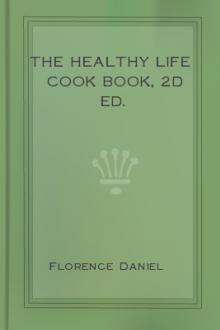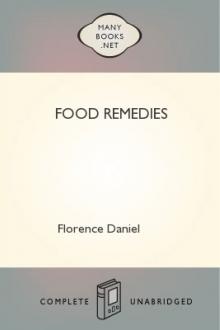The Healthy Life Cook Book, 2d ed. by Florence Daniel (read any book txt) 📕

First put on the chestnuts (without shelling or pricking) in cold water,and boil for an hour. Then remove shells and put the nuts in an enamelledsaucepan with the fat. Fry for 10 minutes. Add the flour gradually,stirring all the time, then add the water. Cook gently for half an hour.Lastly, add the parsley, boil up, and serve.
It is rather nicer if the flour is omitted, the necessary thickness beingobtained by rubbing the soup through a sieve before adding the parsley.Those who do not object to milk may use 1 pint milk and 1 pint water inplace of the 1-1/2 pints water.
5. FRUIT SOUP.
Fruit soups are used extensively abroad, although not much heard of inEngland. But they might be taken at breakfast with advantage by thosevegetarians who have given up the use of tea, coffee and cocoa, and objectto, or dislike, milk. The recipe given here is for apple soup, but pears,plu
Read free book «The Healthy Life Cook Book, 2d ed. by Florence Daniel (read any book txt) 📕» - read online or download for free at americanlibrarybooks.com
- Author: Florence Daniel
- Performer: -
Read book online «The Healthy Life Cook Book, 2d ed. by Florence Daniel (read any book txt) 📕». Author - Florence Daniel
Nuts are the best substitute for flesh meat. Next in order come the pulses. After these come wholewheat and unpolished rice. Both nuts and pulses contain, like flesh meat, a large quantity of proteid in a concentrated form. No one needs more than 1/4 lb. per day, at most, of either. (Eggs, of course, are a good meat substitute, so far as the percentage of proteid is concerned.)
1. ALMONDS, ROASTED.Take any quantity of shelled almonds and blanch by pouring boiling water on them. The skins can then be easily removed. Lay the blanched almonds on a tin, and bake to a pale yellow colour. On no account let them brown, as this develops irritating properties. To be eaten with vegetable stews and pies. (That is, with any stew or pie which contains neither nuts nor pulse.)
2. CHESTNUTS, BOILED.An excellent dish for children and persons with weak digestive powers. The chestnuts need not be peeled or pricked, but merely well covered with cold water and brought to the boil, after which they should boil for a good half hour. Drain off the water and serve hot. They may also be boiled, peeled, mashed and eaten with hot milk.
3. CHESTNUT SAVOURY.Boil for 15 minutes. Shell. Fry in a very little nut fat for 10 minutes. Barely cover with water, and stew gently until tender. When done, add some chopped parsley and thicken with chestnut flour or fine wholemeal. For those who prefer it, milk and dairy butter may be substituted for the water and nut fat.
4. CHESTNUT PIE.1 lb. chestnuts, 1/2 lb. tomatoes, short crust.
Boil the chestnuts for half an hour. Shell. Skin the tomatoes and cut in slices. Well grease a small pie-dish, put in the chestnuts and tomatoes in alternate layers. Cover with short crust (pastry recipe No. 3) and bake until a pale brown. Serve with parsley, tomato, or white sauce.
5. CHESTNUT RISSOLES.1 lb. chestnuts, 1 tablespoon chopped parsley, cornflour and water or 1 egg.
Boil the chestnuts for half an hour. Shell, and well mash with a fork. Add the parsley. Dissolve 1 tablespoon cornflour in 1 tablespoon water. Use as much of this as required to moisten the chestnut, and mix it to a stiff paste. Shape into firm, round, rather flat rissoles, roll in white flour, and fry in deep oil or fat to a golden brown colour. Serve with parsley or tomato sauce.
For those who take eggs, the rissoles may be moistened and bound with a beaten egg instead of the cornflour and water. They may also be rolled in egg and bread-crumbs after flouring.
6. HARICOT BEANS, BOILED.1/2 pint beans, 1 oz. butter, water, 1 teaspoon lemon juice.
The small white or brown haricots should be used for this dish. Wash well, and soak overnight in the water. In the morning put in a saucepan in the same water and bring to the boil. Simmer slowly for 3 hours. When done they mash readily and look floury. Drain off any water not absorbed. Add the butter and lemon juice, and shake over the fire until hot. Serve with parsley or white sauce.
7. HARICOT RISSOLES.1/2 pint haricots, 1 oz. butter, 1 medium onion, water, 1 teaspoon lemon juice, 1 teaspoon mixed herbs, or 1 tablespoon chopped parsley.
Cook the haricots as in preceding recipe. Mash well with a fork, add the onion finely grated, and the parsley or herbs. (This may be omitted if preferred.) Form into firm, round, rather flat rissoles. Roll in white flour. Fry in deep oil or fat to a golden brown colour. Serve with tomato sauce, brown gravy, or parsley sauce.
8. LENTILS, STEWED.1 cup lentils, 1-1/2 cups water, butter (size of walnut), 1 teaspoon lemon juice.
Use either the red Egyptian, or the green German lentils. Wash well in several waters, drain, and put to soak overnight in the water. Use this same water for cooking. Cook very slowly until the lentils are soft and dry. They should just absorb the quantity of water given. (If cooked too quickly it may be necessary to add a little more.) A little thyme or herb powder may be cooked with the lentils, if liked. When done, drain off any superfluous water, add the butter and the lemon juice, shake over the fire until hot. Serve with baked potatoes and tomato sauce.
9. LENTIL PASTE.1/2 pint red lentils, 1/2 pint bread-crumbs, 2 ozs. butter or 1-1/2 oz. nutter, 2 teaspoons lemon juice, 1/2 a nutmeg.
Well wash the lentils and place on the fire with just enough water to cover them. Simmer gently until quite soft. Add the butter, lemon juice, nutmeg, and bread-crumbs. Stir well, heat to boiling point, and cook for 10 minutes. Put in jars, and when cold pour some melted butter or nutter on the top. Tomato juice may be used in place of the lemon juice if preferred.
10. LENTIL AND LEEK PIE.2 cups lentils, 12 small leeks, 4 cups water, short crust.
Put the lentils, water, and leeks, finely shredded, into a covered jar or basin. Bake in a slow oven until done. Put into a greased pie-dish and cover with short crust. (If lentils are very dry, add a little more water.) Bake. Serve with boiled potatoes, brown gravy, and any vegetable in season, except spinach or artichokes.
11. LENTIL RISSOLES.1 teacup red lentils, 2 teacups bread-crumbs, or 1 teacup kornules, cornflour or egg, 1-1/2 teacups water, 4 medium-sized onions, 1 grated lemon rind, 2 teaspoons mixed herbs.
Cook the lentils slowly in a saucepan with the water until they are soft and dry. Steam the onions. If Kornules are used, add as much boiling water to them as they will only just absorb. If bread-crumbs are used, do not moisten them. Add the grated yellow part of the lemon rind and the herbs. Mix all the ingredients well together and slightly moisten with rather less than a tablespoonful of water in which is dissolved a teaspoonful of raw cornflour. This is important, as it takes the place of egg for binding purposes. Shape into round, flat rissoles, roll in white flour, and fry in boiling oil or fat until a golden-brown colour.
A beaten egg may be used for binding in place of the cornflour, and the rissoles may be dipped in egg and rolled in breadcrumbs before frying. Serve hot with brown gravy or tomato sauce. Or cold with salad.
12. MACARONI AND TOMATO.1/4 lb. macaroni, 1 oz. butter, 1/2 lb. tomatoes, parsley.
Use the best quality of macaroni. The smaller kinds are the most convenient as they cook more quickly. Spargetti is a favourite kind with most cooks. Break the macaroni into small pieces and drop it into fast boiling water. Cook with the lid off until quite tender. Be particular about this, as underdone macaroni is not a pleasant dish. (With a little practise the cook will be able to calculate how much water is needed for it all to be absorbed by the time the macaroni is done.) When done, drain well, add the butter, and shake over the fire until hot.
While the macaroni is cooking, skin the tomatoes, break in halves, and put into a tightly-covered saucepan. (Do not add water.) Set at the side of the stove to cook very slowly. They should never boil. When reduced to pulp they are done.
Pile the macaroni in the middle of a rather deep dish, and sprinkle with chopped parsley. Pour the tomato round and serve.
13. MUSHROOM AND TOMATO.Many food reformers consider mushrooms to be unwholesome, and indeed, in the ordinary way, they are best left alone. But if they can be obtained quite fresh, and are not the forced, highly-manured kinds, I do not think they are injurious. But the very large variety, commonly called horse mushrooms, should not be eaten.
Peel and stalk the mushrooms. Examine them carefully for maggots. Fry in just enough nutter to prevent them sticking to the pan. Cook until quite tender. Pile on a warm, deep dish. Slice the tomatoes and fry in the same pan, taking care not to add more nutter than is absolutely necessary. When tender, arrange the tomato slices round and on the mushrooms. Pour a tablespoonful or more, according to the amount cooked, of hot water into the pan. Stir well and boil up. Pour the gravy formed over the mushrooms, and serve.
14. NUT COOKERY.For nut-cookery, a nut mill or food chopper of some kind is necessary. A tiny food chopper, which can be regulated to chop finely or coarsely as required, may be bought for 3s. at most food-reform stores. It also has an attachment which macerates the nuts so as to produce "nut butter." The larger size at 5s. is the more convenient for ordinary use. If only one machine can be afforded, the food chopper should be the one chosen, as it can also be used for vegetables, breadcrumbs, etc. The nut-mill proper flakes the nuts, it will not macerate them, and is useful for nuts only. But flaked nuts are a welcome and pretty addition to fruit salads, stewed fruits, etc.
If the nuts to be milled or ground clog the machine, put them in a warm oven until they just begin to change colour. Then let them cool, and they will be found crisp and easy to work. But avoid doing this if possible, as it dries up the valuable nut oil.
15. NUT ROAST.2 breakfast cups bread-crumbs, 2 medium Spanish onions, or 2 tomatoes, 2 breakfast cups ground nuts, nutter.
Any shelled nuts may be used for this roast. Some prefer one kind only; others like them mixed. Almonds, pine-kernels, new Brazil nuts, and new walnuts are nice alone. Old hazel nuts and walnuts are nicer mixed with pine-kernels. A good mixture is one consisting of equal quantities of blanched almonds, walnuts, hazel nuts, and pine-kernels; where strict economy is a consideration, peanuts may be used. Put a few of each kind alternately into the food chopper and grind until you have enough to fill two cups. Mix with the same quantity breadcrumbs. Grate the onions, discard all tough pieces, using the soft pulp and juice only with which to mix the nuts and crumbs to a very stiff paste. If onions are disliked, skin and mash two tomatoes for the same purpose. Or one onion and one tomato may be used.
Well grease a pie-dish, fill it with the mixture, spread a few pieces of nutter (or butter) on the top, and bake until brown.
Another method.—For those who use eggs, the mixing may be done with a well-beaten egg. The mixture may also be formed into an oblong roast, greased, and baked on a tin. Serve with brown gravy or tomato sauce.
16. NUT RISSOLES.Make a stiff mixture as for nut roast, add a tablespoonful savoury herbs if liked. Form into small, flat rissoles, roll them in white flour, and fry in deep fat or oil. Serve hot with gravy, or cold with salad.
17. NUT PASTE.A nourishing paste for sandwiches is made by macerating pine-kernels with the "nut butter" attachment of the food chopper, and flavouring with a little fresh tomato juice. This must be used the same day as made as it will not keep.
Another method.—Put equal quantities of pea-nuts and pine-kernels into a warm oven until the latter just begin to colour. The skins of the pea-nuts will now be found to rub easily off. Put the mixed nuts through the macerator and mix to a stiff paste with some tomato juice. Put in a saucepan and heat to boiling point. Pour melted butter over top. This may be kept until the next day, but no longer.
18. NUT AND LENTIL ROAST AND RISSOLES.Proceed as for nut roast or rissoles, but use cold stewed lentils (see recipe) in





Comments (0)